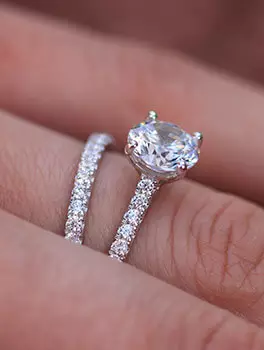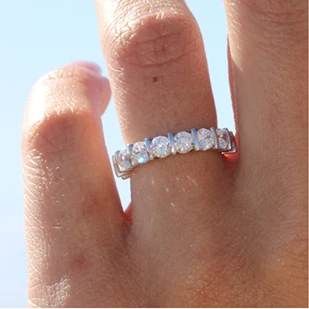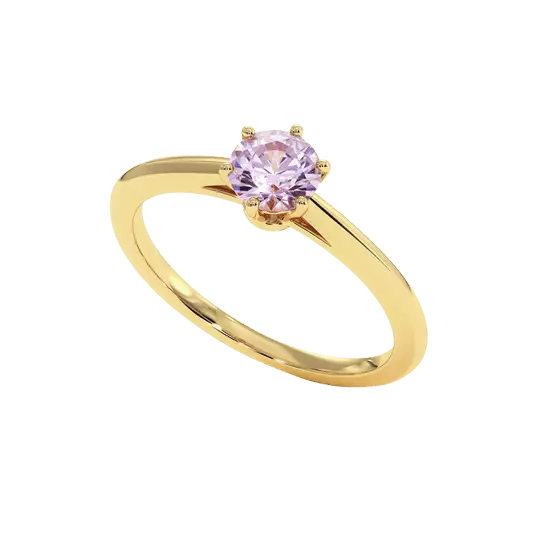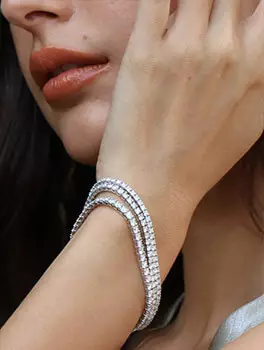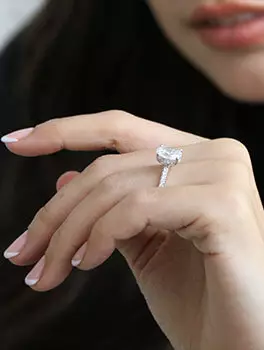Diamond and Jewelry Dictionary
A
● Adamas: Greek term meaning indomitable. From this word, the term diamond is derived. diamond.
● Alloy: Metal obtained by mixing two or more metals.
You haven't provided any text to translate. Please provide the text you want translated.
You didn't provide any text to translate. Please provide the text you want translated.
● Baguette: Rectangular shaped size whose corners have not been truncated.
● Bezel: Facet resulting from the 8/8 cut. The bezels are cut between the corners of the cross cut.
● Diamond Exchange: A place where diamond professionals gather for all their commercial transactions.
● Brilliant: Cutting of a rough diamond into 57 facets, the shape of which has been rounded by the bruting process. There are brilliant cuts with more or fewer facets, but they do not have as much sparkle and fire.
● Brillantage: The process of cutting stars, haléfis, and shards after cutting in 8/8.
● Brucelles: Tweezers with pointed ends that are very useful for diamond cutters, especially in sorting diamonds. These tweezers allow you to pick up the smallest stones.
● Rough: Diamond in its natural state, coming out of the mine, having only been cleaned but not yet shaped or faceted.
C
● Carat: A unit of mass used to weigh diamonds. It is equivalent to 0.2 g.
● Cabochon: A smooth stone with a flat bottom and a domed top.
● Kitten: Used in setting: Part of the jewelry that has claws designed to hold a stone in place.elle be secured on the jewel.
● Cleavage: Operation that involves separating a rough stone into 2 or more pieces by following its cleavage plane.
● Closed setting: Setting technique: The closed setting involves folding a strip of metal over the stone, all around it.elle.
● Heart: Fancy size presenting the shape of a heart.
● Colette is the point of the buttress formed by the meeting of facets at a single point. In old cuts, the colette was faceted.
● Entrusted: Refers to the principle of responsibility and ownership during exchanges and loans of stones or mounts between lapidaries, jewelers, diamond dealers, and goldsmiths. This practice of entrusting is regulated by the case law of the Court of Cassation, which considers the non-return of an entrusted item as a breach of trust, an offense punishable under criminal law.
● Fancy color: Diamond color other than white, such as pink, yellow, green, black, red...
● Crown: The upper part of the cut diamond, above the girdle, including the table and accompanying facets.
● Girdle: Lower part of a faceted stone.
D
● Roughing out: A cutting operation that gives a rough, sawn or unsawn diamond a rounded belt at the girdle. The diamond then takes on a shape similar to that of a spinning top, which allows it to be faceted.
● Black diamond: A natural diamond with many inclusions that make it appear black.
● Diamond dealer: A general term referring to the person specialized in the trade, sale, or shaping of diamonds.
● Doublet: Imitation of a cut diamond, composed of a diamond crown to which a synthetic pavilion is glued at the height of the girdle.
● Hardness: An essential quality of a diamond, which is the most resistant natural body to wear. The Mohs scale tests the hardness of minerals based on their ability to scratch softer materials. The Mohs scale ranges from 1 (the softest) to 10 (the hardest). Talc has a Mohs hardness of 1, while diamond has a hardness of 10.
You haven't provided any text to translate. Please provide the text you want translated.
You didn't provide any text to translate. Please provide the text you want to translate.
● Sparkle: Characteristic brilliance of a cut diamond.
● Star: Triangular facet cut after the 8/8 cut, on the separating edge of 2 bezels. Its base edge is common with the table.
● Emerald: A fancy rectangular cut with truncated corners.
You haven't provided any text to translate. Please provide the text you want translated.
F
● Facet: Flat surface obtained by cutting the diamond or by wearing its surface with a grinding wheel.
● Fancy cut: English term referring to fancy cuts.
● Flawless: An English term referring to a stone free of inclusions.
● Fluorescence: Property of certain diamonds to emit light after exposure to rays. U.V. Depending on its intensity, elle gives the diamond a certain depreciation.
G
● Gem: Generic name for precious stones.
● Frost: Crack in a crystal.
● Engraving: Line drawing on a metal plate done with a chisel or laser. At Celinni, we do stick engravings or English engravings.
H
● Haléfi: Small facet cut on the crown or on the breech from the girdle.
You didn't provide any text to translate. Please provide the text you want to be translated.
● Imitation: Any natural or synthetic stone tending to resemble a diamond or to pass itself off as one is an imitation. It is strictly forbidden to include the name of a diamond in the name of an imitation.
● Inclusions: Accidents, deformations or solid, liquid or gaseous bodies that may be present in a diamond. The inclusions may be visible to the naked eye in a stone.
You haven't provided any text to translate. Please provide the text you want translated.
I
● Bangle: A bangle can come in the form of a bracelet or a ring. A bangle is a piece of jewelry with a uniform diameter. For bracelets, it is called an "open bangle" when it is oval-shaped.
K
● Kimberlite: An ultra-basic, very hard, deep volcanic rock in which diamonds are usually found.
The
● Lapidary: A term improperly used to refer to a diamond cutter, as a lapidary also cuts gemstones other than diamonds.
M
● Macle: Stone resulting from the adhesion or interpretation of one or more diamond crystals under a different crystalline orientation.
● Marquise: A fancy cut with a shape of 2 equal arcs of a circle meeting at a point.
You haven't provided any text to translate. Please provide the text you want translated.
N
● Shuttle: Another term for marquise cut.
You didn't provide any text to translate. Please provide the text you want to translate from French to English.
● Oval: Fancy size in oval shape.
P
● Pavilion: A size of the 8 facets placed on the corners of the breech from the girdle.
● Cleavage plane: A plane perpendicular to the axes or parallel to the faces of the octahedron along which cleavage occurs.
● Pear: Fancy size and also the other name given to the pendeloque cut.
● Hallmark: In France, 2 hallmarks on jewelry are mandatory: The master's hallmark: In the shape of a diamond, containing the initials of the manufacturer and a symbol that he himself has chosen. The state hallmark: Eagle's head to guarantee gold, dog's head to guarantee platinum, Minerva's head to guarantee silver.
● Polariscope: Instrument used to detect internal stresses in rough diamonds.
● Polishing: the action of making the surface of metals smooth, even, and shiny.
● Polishing: The final cutting operation will give the final shine to the cut facets.
● Proportion: A set of criteria including dimensions, angles, and percentages that will determine whether the size of a diamond is in line with the ideal size or not.
● Paving: Covering a metal surface with stones.
● Purity: Quality of a diamond free from inclusions and flaws.
R
● Rhodium plating: Surface treatment. A layer of rhodium is applied to white gold by electrolysis, in order to make it more
● Round: Name frequently given to rhomboidal dodecahedron. Corresponds to the brilliant round cut.
● Rondiste: Band resulting from the roughing of the raw belt of a diamond in order to round it for brilliant cutting. It must be regular, neither too thin nor too wide. Sometimes faceted.
You haven't provided any text to translate. Please provide the text you want translated.
S
● Setting: Method used to securely fix the diamond. The setting can be done using cement or by claws, bars, a rail...
● Substitute: Diamond imitation.
You haven't provided any text to translate. Please provide the text you want translated.
You need to provide a text in French for me to translate it into English.
● Size: The process of giving facets to a rough diamond. By extension, elle also refers to the shape of the diamond when it is cut.
● Old size: Elle It is characterized by poor proportions, mediocre finish, and especially by an "open" culet, meaning faceted. Such a cut can be recut with a facet, but this results in a loss of material from 20% to 30%.
● Fancy cuts: These include marquise, pear, baguette, cushion, and emerald cuts. Excluded are: The 8/8, roses, and suissauts.
● Triangle: Fancy triangle-shaped size, also called tricorn.
● Triboulet: A tool used to measure the size of rings.
● Trigon: Triangular crystallization visible on the surfaces of certain diamonds. These marks are very useful for determining the crystalline structure of a stone.
You haven't provided any text to translate. Please provide the text you want translated.
V
● View: Assortment of rough diamonds offered by the "Central Selling Organizations" of De Beers, about ten times a year, to a limited number of selected buyers.
The keywords of the diamond:
Chemical composition: The diamond is made up of pure Carbon (C).
Density: The specific weight of a diamond is on average 3.52.
Its density can vary depending on the trace elements and inclusions present in the diamond.
In Australia: 3.54 for the white diamond and 3.52 for the yellow diamond.
In Africa, the density approaches 3.525.
In Brazil, brown diamonds can have a density of up to 3.60.
In comparison with other minerals:
Corundum has a density of 3.93. Garnet has a density of 3.60. Emerald has a density of 2.74. Quartz has a density of 2.65.
Hardness: The diamond is the hardest element existing in nature. It is a 10 on the Mohs scale. This is a scale that is more easily defined by comparison. The hardness of a body can be estimated by the difficulty in scratching, wearing, or deforming it.
To find a comparison point with diamond: Malachite: 3.5 to 4, Turquoise: 6, Garnet: 7, Emerald: 7.5, Corundum: 9.
"Fun fact": One might think that diamonds are barely harder than corundums, yet on a quantitative scale, corundum is at 1,000 while diamond is at 140,000.
The exceptional hardness of the diamond proves its difficulty and complexity to be worked on.
Refraction: The diamond has the highest refractive index of all gemstones.
The refraction of the diamond is 2.4176 in yellow light.
Dispersion: The dispersion is very strong and through the play of facets, forms a prism., elle causes the shimmering of the colors of the rainbow.
"Fun fact": By turning a cut diamond towards oneself and observing a facet on which light falls, it can be seen that the brilliance increases more and more until it reaches its maximum, then it decreases, taking on a shine that is intermediate between that of crystal and that of polished steel.
Birefringence: The diamond constantly has birefringence in the polariscope even if it is isotropic. The birefringence is due to its internal tensions, as few diamonds are completely free of them.
Fluorescence: When a diamond is exposed to ultraviolet light, it may emit visible light of varying colors, blue, white.
Imitations: No stone has ever been imitated as much as the diamond. It arouses covetousness and inspires the desire to be copied.
The German Von Strass discovered that coating cut mercury gave it a shine almost comparable to that of a diamond. He invented strass, which is a very inexpensive imitation of a diamond.
Even today, rhinestones or lead glass are still widely used in French jewelry.
Some natural stones have usurped the name diamond, likely in an attempt to mislead.
For example:
● Alaska Diamond = Quartz
● Alumina Diamond = Synthetic Corundum
● Mature Diamond = Colorless Zircon
Discovery of diamond deposits:
● 8th Century BC: India
● 6th century AD: Borneo
● 1726: Brazil
● 1829: Russia
● 1850: Australia
● 1866: South Africa
Cutting Centers: The main diamond cutting centers are: South Africa, Belgium, Brazil, China, Korea, France, Israel, India.
Main markets: The main diamond markets are located in South Africa, Germany, Australia, Belgium, Brazil, the Emirates, France, Spain, Great Britain, the Netherlands, Hong Kong, Italy, Japan, Singapore, and the United States.
Focus on diamond mining in India: From antiquity to the 18th century, India held almost a monopoly on diamond production. The diamond was considered a gift from the gods.
In India, there are 3 major diamond mining groups: In the North, East, and South.
The famous diamond "Koh-i-noor" was discovered in the 16th century in the Kollur mines and the famous "Regent" in the vicinity of the partial mine.
Faceting principle: This principle is based on transforming a rough diamond into a faceted diamond.








NEWSLETTER
Sign up to receive the latest news regarding
the products and services CELINNI, and much more.





















